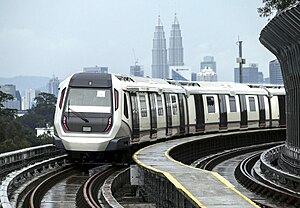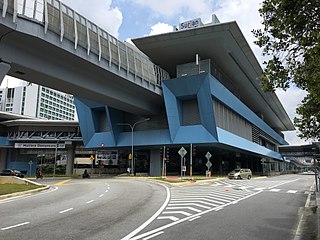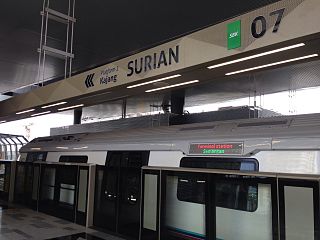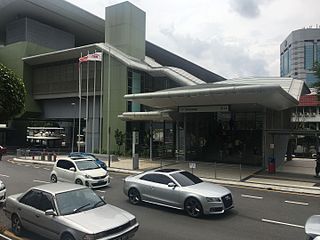| Sungai Buloh–Kajang line | |||
|---|---|---|---|
| 9 | |||
 | |||
| Overview | |||
| Native name | MRT Laluan Sungai Buloh–Kajang | ||
| Type | Rapid transit | ||
| System | Rapid KL- KVMRT Line 1 (MRT1) | ||
| Status | Fully operational | ||
| Termini | SBK01 Sungai Buloh SBK35 Kajang | ||
| Stations | 31 + 3 reserved stations | ||
| Services | Sungai Buloh – Semantan (16 Dec 2016) Semantan – Kajang (17 July 2017) | ||
| Daily ridership | 131,843 (Second Quarter 2018) [1] | ||
| Ridership | 22.25 million (2017) [1] | ||
| Line number | 9 (green) | ||
| Website | myrapid | ||
| Operation | |||
| Opened | Phase 1 16 December 2016 [2] Sungai Buloh - Semantan Phase 2 17 July 2017 Semantan - Kajang | ||
| Owner | Mass Rapid Transit Corporation Sdn Bhd | ||
| Operator(s) | Rapid Rail Sdn Bhd (Prasarana Malaysia Berhad) | ||
| Conduction system | Automated and driverless | ||
| Depot(s) | Sungai Buloh Depot and Kajang Depot | ||
| Rolling stock | Siemens Inspiro 58 four-car trainsets Width: 3.1 m (10 ft) Length: 89.56 m (293.8 ft) | ||
| Technical | |||
| Line length | 51 km (32 mi) Elevated: 41.5 km (25.8 mi) Underground: 9.5 km (5.9 mi) | ||
| Track gauge | 1,435 mm (4 ft 8 1⁄2 in) standard gauge | ||
| Electrification | Third rail, 750 VDC | ||
| |||
9 - Sungai Buloh-Kajang Line | |||||||||||||||||||||||||||||||||||||||||||||||||||||||||||||||||||||||||||||||||||||||||||||||||||||||||||||||||||||||||||||||||||||||||||||||||||||||||||||||||||||||||||||||||||||||||||||||||||||||||||||||||||||||||||||||||||||||||||||||||||||||||||||||||||||||||||||||||||||||||||||||||||||||||||||||||||||||||||||||||||||||||||||||||||||||||||||||||||||||||||||||||||||||||||||||||||||||||||||||||||||||||||||||||||||||||||||||||||||||||||||||||||||||||||||||||||||||||||||||||||||||||||||||||||||||||||||||||||
|---|---|---|---|---|---|---|---|---|---|---|---|---|---|---|---|---|---|---|---|---|---|---|---|---|---|---|---|---|---|---|---|---|---|---|---|---|---|---|---|---|---|---|---|---|---|---|---|---|---|---|---|---|---|---|---|---|---|---|---|---|---|---|---|---|---|---|---|---|---|---|---|---|---|---|---|---|---|---|---|---|---|---|---|---|---|---|---|---|---|---|---|---|---|---|---|---|---|---|---|---|---|---|---|---|---|---|---|---|---|---|---|---|---|---|---|---|---|---|---|---|---|---|---|---|---|---|---|---|---|---|---|---|---|---|---|---|---|---|---|---|---|---|---|---|---|---|---|---|---|---|---|---|---|---|---|---|---|---|---|---|---|---|---|---|---|---|---|---|---|---|---|---|---|---|---|---|---|---|---|---|---|---|---|---|---|---|---|---|---|---|---|---|---|---|---|---|---|---|---|---|---|---|---|---|---|---|---|---|---|---|---|---|---|---|---|---|---|---|---|---|---|---|---|---|---|---|---|---|---|---|---|---|---|---|---|---|---|---|---|---|---|---|---|---|---|---|---|---|---|---|---|---|---|---|---|---|---|---|---|---|---|---|---|---|---|---|---|---|---|---|---|---|---|---|---|---|---|---|---|---|---|---|---|---|---|---|---|---|---|---|---|---|---|---|---|---|---|---|---|---|---|---|---|---|---|---|---|---|---|---|---|---|---|---|---|---|---|---|---|---|---|---|---|---|---|---|---|---|---|---|---|---|---|---|---|---|---|---|---|---|---|---|---|---|---|---|---|---|---|---|---|---|---|---|---|---|---|---|---|---|---|---|---|---|---|---|---|---|---|---|---|---|---|---|---|---|---|---|---|---|---|---|---|---|---|---|---|---|---|---|---|---|---|---|---|---|---|---|---|---|---|---|---|---|---|---|---|---|---|---|---|---|---|---|---|---|---|---|---|---|---|---|---|---|---|---|---|---|---|---|---|---|---|---|---|---|---|---|---|---|---|---|---|---|---|---|---|---|---|---|---|---|---|---|---|---|---|---|---|---|---|---|---|---|---|---|---|---|---|---|---|---|---|---|---|---|---|---|---|---|---|---|---|---|---|---|---|---|---|---|---|---|---|---|---|---|---|---|---|---|---|---|---|---|---|---|---|---|---|---|---|---|---|---|---|
| |||||||||||||||||||||||||||||||||||||||||||||||||||||||||||||||||||||||||||||||||||||||||||||||||||||||||||||||||||||||||||||||||||||||||||||||||||||||||||||||||||||||||||||||||||||||||||||||||||||||||||||||||||||||||||||||||||||||||||||||||||||||||||||||||||||||||||||||||||||||||||||||||||||||||||||||||||||||||||||||||||||||||||||||||||||||||||||||||||||||||||||||||||||||||||||||||||||||||||||||||||||||||||||||||||||||||||||||||||||||||||||||||||||||||||||||||||||||||||||||||||||||||||||||||||||||||||||||||||
| |||||||||||||||||||||||||||||||||||||||||||||||||||||||||||||||||||||||||||||||||||||||||||||||||||||||||||||||||||||||||||||||||||||||||||||||||||||||||||||||||||||||||||||||||||||||||||||||||||||||||||||||||||||||||||||||||||||||||||||||||||||||||||||||||||||||||||||||||||||||||||||||||||||||||||||||||||||||||||||||||||||||||||||||||||||||||||||||||||||||||||||||||||||||||||||||||||||||||||||||||||||||||||||||||||||||||||||||||||||||||||||||||||||||||||||||||||||||||||||||||||||||||||||||||||||||||||||||||||
The MRT Sungai Buloh–Kajang line, or known as SBK Line, is the ninth rail transit line and the second fully automated and driverless rail system in the Klang Valley area, Malaysia after the . It is a part of Greater KL/Klang Valley Integrated Transit System . The line is numbered and coloured Green on official transit maps.

Klang Valley is an area in Malaysia which is centered in Kuala Lumpur, and includes its adjoining cities and towns in the state of Selangor. A more recent alternative reference to this would be Greater Kuala Lumpur.

The Klang Valley Integrated Transit System (TRANSIT) is a railway network that primarily serves the area of Klang Valley and Greater Kuala Lumpur. The system currently consists of 11 fully operating rail lines; two commuter rail lines, five rapid transit lines, one bus rapid transit line and two airport rail link to Kuala Lumpur International Airport and another one to Subang Airport.
Contents
- Background
- Line information
- Alignment
- Services and rolling stock
- Depots
- History
- Chronology
- List of Stations
- Stations
- See also
- Notes and references
- Notes
- References
- External links
It is one of three planned rail lines under Klang Valley Mass Rapid Transit Project by MRT Corp. The Phase 1 between and commenced service on 16 December 2016. [3] Phase 2 between Muzium Negara and Kajang was opened on 17 July 2017, as a free shuttle service, by former Malaysian Prime Minister, Dato' Seri Najib Tun Razak in a ceremony at the Tun Razak Exchange station. Full revenue service between Sungai Buloh and Kajang began the following day. [4] [5] [6]

The Prime Minister of Malaysia is the head of government and the highest political office in Malaysia. The Yang di-Pertuan Agong appoints Prime Minister as a Member of Parliament (MP) who, in his opinion, is most likely to command the confidence of a majority of MPs. The Prime Minister chairs the Cabinet of Malaysia, the de facto executive branch of government. On 18 October 2018, 7th Prime Minister, Mahathir Mohamad, announced a two-term limit to all Cabinet Profolio.

Dato' Sri Haji Mohammad Najib bin Tun Haji Abdul Razak is a Malaysian politician who served as the 6th Prime Minister of Malaysia from 2009 to 2018. He was the former President of the United Malays National Organisation (UMNO), the leading party in Malaysia's Barisan Nasional (BN) coalition, which maintained control of Malaysia's government as a parliamentary majority for more than sixty years until the coalition's defeat in the 2018 general election.

























